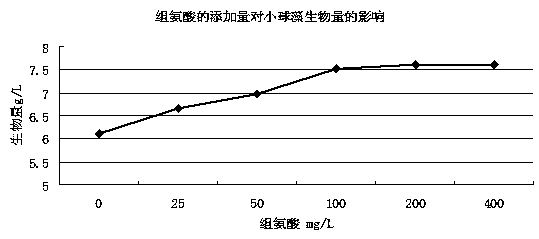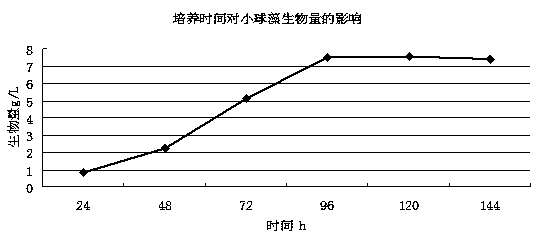Method for reducing adherence of chlorella
A technology of chlorella and common chlorella, applied in the biological field, can solve the problems of algae cells, such as difficulty in absorbing nutrients, poor living environment, and adherence to the wall
- Summary
- Abstract
- Description
- Claims
- Application Information
AI Technical Summary
Problems solved by technology
Method used
Image
Examples
Embodiment 1
[0025] A method for reducing chlorella adherence, comprising the steps of:
[0026] The Chlorella vulgaris liquid in the logarithmic growth phase was inoculated into the reaction tank containing the culture solution according to the inoculation amount of 5%, and the inoculation density was 1×10 6 1 / ml, then add 100mg / L amino acid, cultivate for 96h, centrifuge, and collect the algae cells; the culture conditions are: light intensity 5000lux, culture at 22°C, light-to-dark ratio of 18:6, ventilation rate of 0.2vvm; The components of the culture medium are: glucose 3g / L, potassium nitrate 1.5g / L, sodium chloride 1g / L, borax 0.5g / L, potassium dihydrogen phosphate 0.5g / L, calcium carbonate 0.1g / L, heptahydrate Magnesium sulfate 50 mg / L, ferric ammonium citrate 20 mg / L, sodium naphthalene acetate 10 mg / L, gibberellin 10 mg / L; the amino acid is histidine.
Embodiment 2
[0028] A method for reducing chlorella adherence, comprising the steps of:
[0029] The Chlorella vulgaris liquid in the logarithmic growth phase was inoculated into the reaction tank containing the culture solution according to the inoculation amount of 5%, and the inoculation density was 2×10 6 1 / ml, then add 100mg / L amino acid, cultivate for 96h, centrifuge, and collect algae cells; the culture conditions are: light intensity 5000lux, culture at 22°C, light-to-dark ratio 14:10, ventilation rate 0.3vvm; The components of the culture medium are: glucose 3g / L, potassium nitrate 1.5g / L, sodium chloride 1g / L, borax 0.5g / L, potassium dihydrogen phosphate 0.5g / L, calcium carbonate 0.1g / L, heptahydrate Magnesium sulfate 50 mg / L, ferric ammonium citrate 20 mg / L, sodium naphthalene acetate 10 mg / L, gibberellin 10 mg / L; the amino acid is a mixture of histidine and arginine in a 1:1 mass ratio.
Embodiment 3
[0043] The influence of chlorella adherence and biomass in embodiment 1-2 and comparative example 1-4:
[0044] Observe the growth of algal cells in each group, and divide the phenomenon of algal cell adhesion into four grades. Among them, the first grade is very serious, and the algal cells are aggregated into blocks, tightly combined, and a large number of deaths; the second grade Grade 3: slightly adherent, algal cells aggregated loosely, and 0 or a small amount of death.
PUM
 Login to View More
Login to View More Abstract
Description
Claims
Application Information
 Login to View More
Login to View More - R&D
- Intellectual Property
- Life Sciences
- Materials
- Tech Scout
- Unparalleled Data Quality
- Higher Quality Content
- 60% Fewer Hallucinations
Browse by: Latest US Patents, China's latest patents, Technical Efficacy Thesaurus, Application Domain, Technology Topic, Popular Technical Reports.
© 2025 PatSnap. All rights reserved.Legal|Privacy policy|Modern Slavery Act Transparency Statement|Sitemap|About US| Contact US: help@patsnap.com


